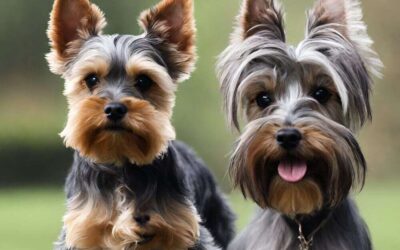Introduction
The Yorkie and American Eskimo are two popular dog breeds that are often compared to each other. Both breeds are small and relatively easy to care for, but they have different personalities and grooming requirements. In this article, we will compare the Yorkie and American Eskimo in terms of appearance, temperament, exercise needs, grooming needs, health issues, cost of ownership, and where to find each breed. We will also provide tips on which breed is right for you based on your lifestyle and preferences.
Breed Comparison Table
| Aspect | Yorkshire Terrier (Yorkie) | American Eskimo Dog |
|---|---|---|
| Size | ||
| Temperament | ||
| Grooming Needs | ||
| Lifespan | ||
| Exercise Needs | ||
| Training Difficulty | ||
| Common Health Issues |
Differences in Appearance
Yorkshire Terrier:
- Small, compact dog
- Long, silky coat
- Weighs between 4 and 7 pounds
- Stands between 8 and 10 inches tall
American Eskimo:
- Medium-sized dog
- Thick, double coat
- Weighs between 25 and 35 pounds
- Stands between 15 and 20 inches tall
Differences in Temperament
Yorkies are known for being feisty, intelligent, and loyal companions. They are also very protective of their owners and can be wary of strangers. However, they are also affectionate and love to play.
American Eskimos are also intelligent and loyal, but they are typically more gentle and outgoing than Yorkies. They are also less likely to bark excessively. American Eskimos are very social dogs and enjoy being around people.
Overall, Yorkies and American Eskimos are both great dogs for families. However, Yorkies may be a better choice for people who are looking for a more protective and alert dog, while American Eskimos may be a better choice for people who are looking for a more gentle and social dog.
Differences in Exercise Needs
Yorkies are a small breed of dog and do not require a lot of exercise. They are happy with a few short walks each day, and they can also be entertained with indoor activities such as playing fetch or tug-of-war.
American Eskimos are a medium-sized breed of dog and require more exercise than Yorkies. They need at least 30 minutes of exercise each day, and they enjoy playing fetch, running, and hiking.
It is important to note that both breeds of dogs can become overweight if they do not get enough exercise. It is important to find a balance that works for your individual dog and to make sure they get the exercise they need to stay healthy.
Differences in Grooming Needs
Yorkies require a moderate amount of grooming, as they have a double coat that sheds seasonally. They should be brushed at least once a week to remove loose hair and keep their coat healthy. Yorkies also need to be bathed regularly, as they can get dirty easily.
American Eskimos require a high level of grooming, as they have a thick double coat that sheds heavily. They should be brushed at least twice a week to remove loose hair and keep their coat healthy. American Eskimos also need to be bathed regularly, as they can get dirty easily.
Here is a table summarizing the grooming needs of Yorkies and American Eskimos:
| Grooming Need | Yorkie | American Eskimo |
|---|---|---|
| Brushing | Once a week | Twice a week |
| Bathing | Regularly | Regularly |
Differences in Health Issues
Yorkies are generally healthy dogs, but they can be prone to certain health conditions, such as:
| Disease | Description |
|---|---|
| Intervertebral disc disease (IVDD) | A common condition in Yorkies in which the jelly-like cushion between one or more vertebrae slips or ruptures, causing pain and mobility issues |
| Dental disease | Yorkshire Terriers are prone to dental problems, such as periodontal disease, which can lead to tooth loss and other health issues |
| Collapsed trachea | A condition in which the tracheal rings that support the windpipe weaken, causing a chronic dry cough, shortness of breath, difficulty exercising, and even fainting |
| Luxating patellas | A condition in which the kneecaps temporarily slip out of place, causing pain and mobility issues |
| Hemorrhagic gastroenteritis (HGE) | A form of diarrhea that can be life-threatening for Yorkies because small dogs dehydrate more quickly than large dogs |
| Pancreatitis | A condition involving inflammation of the pancreas, which Yorkies are prone to |
| Retinal dysplasia | A condition in which the retina doesn’t develop properly, leading to vision problems |
| Portosystemic shunt | A condition in which the liver doesn’t function properly, leading to a variety of symptoms, including vomiting, diarrhea, and seizures |
| Hypoglycemia | A condition in which the blood sugar level drops too low, causing weakness, lethargy, and seizures |
| Legg-Perthes disease | A condition in which the hip joint begins to die, leading to pain and mobility issues |
American Eskimos are also generally healthy dogs, but they can be prone to certain health conditions, such as:
| Disease | Description |
|---|---|
| Parvo | A viral infection that can cause severe vomiting, diarrhea, and dehydration |
| Rabies | A viral infection that affects the nervous system and can be fatal |
| Distemper | A viral infection that can cause respiratory and neurological symptoms |
| Dental disease | American Eskimo Dogs are susceptible to dental problems, such as periodontal disease |
| Obesity | American Eskimo Dogs can be prone to obesity, which can lead to a variety of health problems |
| Cataracts | A condition in which the lens of the eye becomes cloudy, leading to vision problems |
| Progressive retinal atrophy | A condition in which the photoreceptors in the eye begin to degenerate, leading to loss of vision |
| Hip dysplasia | An inherited condition in which the hip joint doesn’t develop properly, leading to arthritis and pain |
It is important to be aware of the potential health risks associated with both Yorkies and American Eskimos so that you can take steps to prevent or manage them. By working with your veterinarian, you can help your dog live a long and healthy life.
Differences in Cost of Ownership
The American Eskimo Dog is generally less expensive to own than the Yorkshire Terrier. This is because they are smaller dogs and require less food, grooming, and veterinary care. The average annual cost of owning an American Eskimo Dog is around $600, while the average annual cost of owning a Yorkshire Terrier is around $800.
However, there are some factors that can affect the cost of owning either breed, such as the breeder, the location, and the individual dog’s needs. It is important to do your research and compare prices before making a decision.
Where to Find Each Breed
You can find Yorkies and American Eskimos at most reputable breeders. However, there are a few things you should keep in mind when looking for a puppy.
- Do your research. There are many different factors to consider when choosing a dog breed, such as size, temperament, and grooming needs. Make sure you do your research to find a breed that is a good fit for your lifestyle.
- Visit the breeder in person. This is a great opportunity to meet the puppies and their parents, and to ask the breeder any questions you have.
- Get a health guarantee. A reputable breeder will offer a health guarantee on their puppies. This means that they will take back the puppy and refund your money if it develops a serious health condition.
You can also find Yorkies and American Eskimos at animal shelters and rescue organizations. These dogs are often abandoned or surrendered by their owners, and they are looking for a loving new home.
- Adopting a rescue dog is a great way to give a homeless animal a second chance.
- Rescue dogs come in all shapes and sizes, so you’re sure to find one that’s a good fit for your lifestyle.
- Rescue organizations often offer adoption assistance, such as training and veterinary care.
If you’re considering adopting a dog, be sure to do your research and find a reputable rescue organization. You can find a list of reputable rescue organizations in your area by doing a Google search.
Which Breed is Right for You?
Both the Yorkie and the American Eskimo are great dogs, but they each have their own unique personality and set of needs. It is important to consider which breed is the best fit for your lifestyle and family before making a decision.
Here are some factors to consider when choosing between a Yorkie and an American Eskimo:
- Size: The Yorkie is a small dog, while the American Eskimo is a medium-sized dog. If you have limited space, the Yorkie may be a better option.
- Energy level: The Yorkie is a high-energy dog, while the American Eskimo is a moderate-energy dog. If you are looking for a dog that will be able to keep up with you on long walks or hikes, the American Eskimo may be a better choice.
- Grooming needs: The Yorkie requires more grooming than the American Eskimo. If you are not prepared to brush your dog’s hair regularly, the American Eskimo may be a better option.
- Health issues: Both the Yorkie and the American Eskimo are prone to certain health problems. It is important to be aware of these problems before making a decision.
Final Thoughts
In comparing Yorkies and American Eskimo Dogs, one should consider their differing lifestyles and care requirements. Key aspects include choosing the right yorkie dog clothes for Yorkies and suitable apparel for American Eskimo Dogs. Grooming tools like brushes for yorkies are essential for maintaining their coats. Also, be informed about potential yorkie health issues versus those common in American Eskimo Dogs to ensure their well-being.
FAQs Before Purchasing a Yorkie or American Eskimo Dog
1. Are Yorkies and American Eskimo Dogs suitable for families with children?
Both breeds can be suitable for families, but supervision is always recommended with smaller children. Yorkies, due to their small size, can be easily injured, whereas American Eskimo Dogs, although friendly, can sometimes be wary of strangers.
2. How often do these breeds need grooming?
Yorkies require frequent grooming due to their long, silky coat, while American Eskimo Dogs, with their double coat, also benefit from regular grooming to reduce shedding and prevent matting.
3. Are they apartment-friendly dogs?
Since they are so little, Yorkies are frequently recommended as great companions for those who live in apartments. If they have enough exercise and mental stimulation, American Eskimo Dogs may do OK in urban environments like apartments.
4. How well do they adapt to other pets?
Both breeds can coexist peacefully with other pets, especially if introduced at a young age. However, early socialization and proper introductions are key to ensuring a harmonious environment.
5. How much training do they require?
Both breeds benefit from consistent training. While Yorkies can be independent and sometimes stubborn, American Eskimo Dogs are intelligent and eager to please, making training relatively straightforward with positive reinforcement techniques.

As a lifelong dog lover, I fell in love with Yorkies for their spunky personalities, intelligence, and unwavering loyalty.
As a dedicated Yorkie owner, I have spent years learning about the breed and how to provide the best possible care for them. From finding the proper diet to exercise, and so much more! I take every aspect of my Yorkie’s life seriously.
In addition to being a loving dog parent, I’m an avid blogger, sharing my experiences and insights on all things Yorkie-related. From training tips to grooming advice, Yorkieclothing.com is a go-to resource for other Yorkie owners worldwide.




